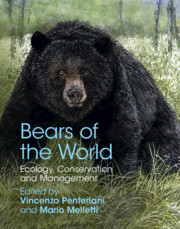Book contents
- Bears of the World
- Bears of the World
- Copyright page
- Dedication
- Frontispiece
- Contents
- Contributors
- Foreword
- Acknowledgments
- Introduction
- Part I Systematics, Ecology, and Behavior
- Chapter 1 Systematics, Evolution, and Genetics of Bears
- Chapter 2 Mating Strategies
- Chapter 3 Interspecific Interactions between Brown Bears, Ungulates, and Other Large Carnivores
- Chapter 4 Adaptations and Competitive Interactions of Tropical Asian Bear Species Define Their Biogeography: Past, Present, and Future
- Chapter 5 Remarkable Adaptations of the American Black Bear Help Explain Why it is the Most Common Bear: A Long-Term Study from the Center of its Range
- Part II Species Accounts
- Part III Human–Bear Coexistence
- Part IV Conservation and ManagementConservation and Management
- Index
- Miscellaneous Endmatter
- Plate Section (PDF Only)
- References
Chapter 5 - Remarkable Adaptations of the American Black Bear Help Explain Why it is the Most Common Bear: A Long-Term Study from the Center of its Range
from Part I - Systematics, Ecology, and Behavior
Published online by Cambridge University Press: 16 November 2020
- Bears of the World
- Bears of the World
- Copyright page
- Dedication
- Frontispiece
- Contents
- Contributors
- Foreword
- Acknowledgments
- Introduction
- Part I Systematics, Ecology, and Behavior
- Chapter 1 Systematics, Evolution, and Genetics of Bears
- Chapter 2 Mating Strategies
- Chapter 3 Interspecific Interactions between Brown Bears, Ungulates, and Other Large Carnivores
- Chapter 4 Adaptations and Competitive Interactions of Tropical Asian Bear Species Define Their Biogeography: Past, Present, and Future
- Chapter 5 Remarkable Adaptations of the American Black Bear Help Explain Why it is the Most Common Bear: A Long-Term Study from the Center of its Range
- Part II Species Accounts
- Part III Human–Bear Coexistence
- Part IV Conservation and ManagementConservation and Management
- Index
- Miscellaneous Endmatter
- Plate Section (PDF Only)
- References
Summary
American black bears (Ursus americanus) are by far the most abundant species of bear, numbering more than twice that of all other bear species combined. Many US states share this history of black bear decline and resurgence, and today have burgeoning bear populations. To a large extent, the comeback of this species has been a consequence of restrictions on killing, and a fundamental change in how the public perceives and reacts to black bears. However, the success of this species is also due to its biological adaptiveness – its ability to live in a vast array of habitats, to adapt to radically variable food conditions, and to tolerate the presence of people and the changes they have imposed on the landscape. This chapter highlights the adaptability of the black bear using an extensive and diverse data set spanning 38 years. We explore reasons for their commonness, using a long-term case study from near the geographic center of this species’ range: Minnesota, USA.
- Type
- Chapter
- Information
- Bears of the WorldEcology, Conservation and Management, pp. 53 - 62Publisher: Cambridge University PressPrint publication year: 2020
References
- 4
- Cited by

